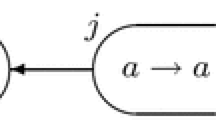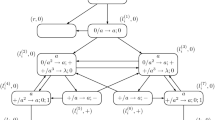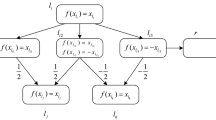Abstract
Membrane computing models based on cell structure and function have important applications in computer science and provide new theories and methods for modeling biological systems. The spiking neural P system based on the min-sequentiality strategy is a special kind of membrane computing model. Anti-spikes and inhibitory functions are introduced into spiking neural P systems based on the min-sequentiality strategy. We construct two sequential spiking neural P systems with anti-spikes in different ways. The corresponding modules of the two systems are designed separately. Finally, we prove that the two spiking neural P systems with anti-spikes based on the min-sequentiality strategy are universal as both number generators and acceptors.
Access this chapter
Tax calculation will be finalised at checkout
Purchases are for personal use only
Similar content being viewed by others
References
Păun, G.: Computing with membranes. J. Comput. Syst. Sci. 61(1), 108–143 (2000). Oxford University Press, Cambridge (2010)
Păun, G.: Membrane Computing - An Introduction. Springer, Berlin (2002). https://doi.org/10.1007/978-3-642-56196-2
Ionescu, M., Păun, G., Yokomori, T.: Spiking neural P systems. Fund. Inform. 71(2–3), 279–308 (2006)
Song, T., Pan, L., Păun, G.: Asynchronous spiking neural P systems with local synchronization. Inform. Sci. 219, 197–207 (2013)
Song, T., Pan, L., Păun, G.: Spiking neural P systems with rules on synapses. Theor. Comput. Sci. 529, 82–95 (2014)
Song, B., Pérez-Jiménez, M.J., Pan, L.: An efficient time-free solution to QSAT problem using P systems with proteins on membranes. Inform. Comput. 256, 287–299 (2017)
Song, B., Zhang, C., Pan, L.: Tissue-like P systems with evolutional symport/antiport rules. Inform. Sci. 378, 177–193 (2017)
Wu, T., Zhang, Z., Păun, G., Pan, L.: Cell-like spiking neural P systems. Theor. Comput. Sci. 623, 180–189 (2016)
Wu, T., Zhang, Z., Pan, L.: On languages generated by cell-like spiking neural P systems. IEEE T. NanoBiosci. 15(5), 455–467 (2016)
Pan, L., Păun, G., Zhang, G., Neri, F.: Spiking neural P systems with communication on request. Int. J. Neural Syst. 27(8), 1750042 (2017). https://doi.org/10.1142/S0129065717500423
Pan, L., Wu, T., Su, Y., Vasilakos, A.V.: Cell-like spiking neural P systems with request rules. IEEE T. NanoBiosci. 16(6), 513–522 (2017)
Ibarra, O.H., Păun, A., Rodríguez-Patón, A.: Sequential SNP systems based on min/max spike number. Theor. Comput. Sci. 410, 2982–2991 (2009)
Păun, A., Sidoroff, M.: Sequentiality induced by spike number in SNP systems: small universal machines. In: Gheorghe, M., Păun, G., Rozenberg, G., Salomaa, A., Verlan, S. (eds.) CMC 2011. LNCS, vol. 7184, pp. 333–345. Springer, Heidelberg (2012). https://doi.org/10.1007/978-3-642-28024-5_22
Zhang, X., Luo, B., Fang, X., Pan, L.: Sequential spiking neural P systems with exhaustive use of rules. BioSystems 108(1–3), 52–62 (2012)
Zhang, X., Zeng, X., Luo, B., Pan, L.: On some classes of sequential spiking neural P systems. Neural Comput. 26(5), 974–997 (2014)
Jiang, K., Song, T., Pan, L.: Universality of sequential spiking neural P systems based on minimum spike number. Theor. Comput. Sci. 499, 88–97 (2013)
Pan, L., Păun, G.: Spiking neural P systems with anti-spikes. Int. J. Comput. Commun. 4(3), 273–282 (2009)
Rozenberg, G., Salomaa, A. (eds.): Handbook of Formal Languages, vol. 3. Springer, Berlin (1997). https://doi.org/10.1007/978-3-642-59126-6
Minsky, M.: Computation - Finite and Infinite Machines. Prentice Hall, Englewood Cliffs (1967)
Acknowledgments
This work was supported by Anhui Provincial Natural Science Foundation (1808085MF173), and Natural Science Key Research Project for Higher Education Institutions of Anhui Province (KJ2017A942).
Author information
Authors and Affiliations
Corresponding author
Editor information
Editors and Affiliations
Rights and permissions
Copyright information
© 2018 Springer Nature Singapore Pte Ltd.
About this paper
Cite this paper
Li, L., Jiang, K. (2018). Spiking Neural P Systems with Anti-spikes Based on the Min-Sequentiality Strategy. In: Qiao, J., et al. Bio-inspired Computing: Theories and Applications. BIC-TA 2018. Communications in Computer and Information Science, vol 951. Springer, Singapore. https://doi.org/10.1007/978-981-13-2826-8_9
Download citation
DOI: https://doi.org/10.1007/978-981-13-2826-8_9
Published:
Publisher Name: Springer, Singapore
Print ISBN: 978-981-13-2825-1
Online ISBN: 978-981-13-2826-8
eBook Packages: Computer ScienceComputer Science (R0)




